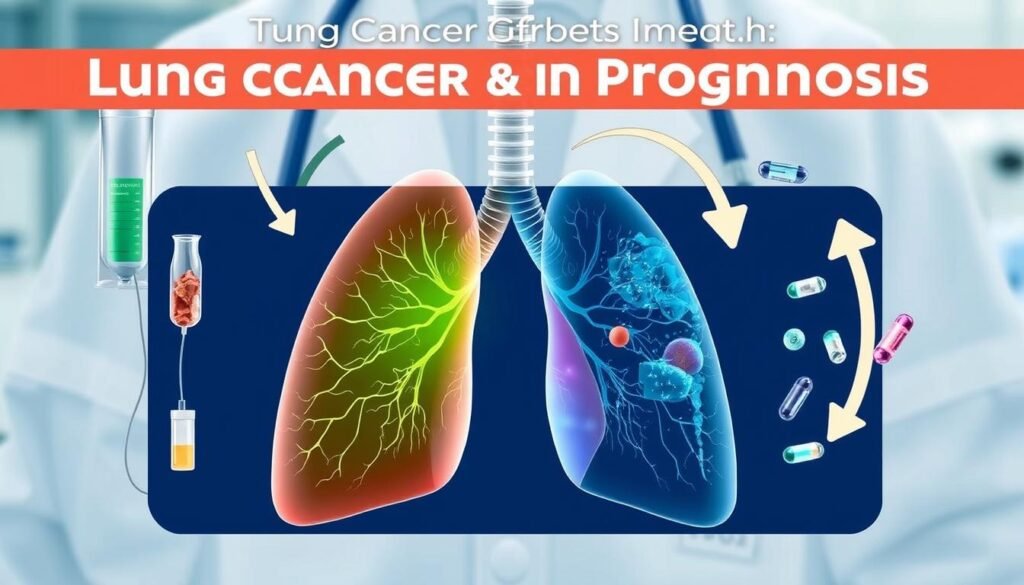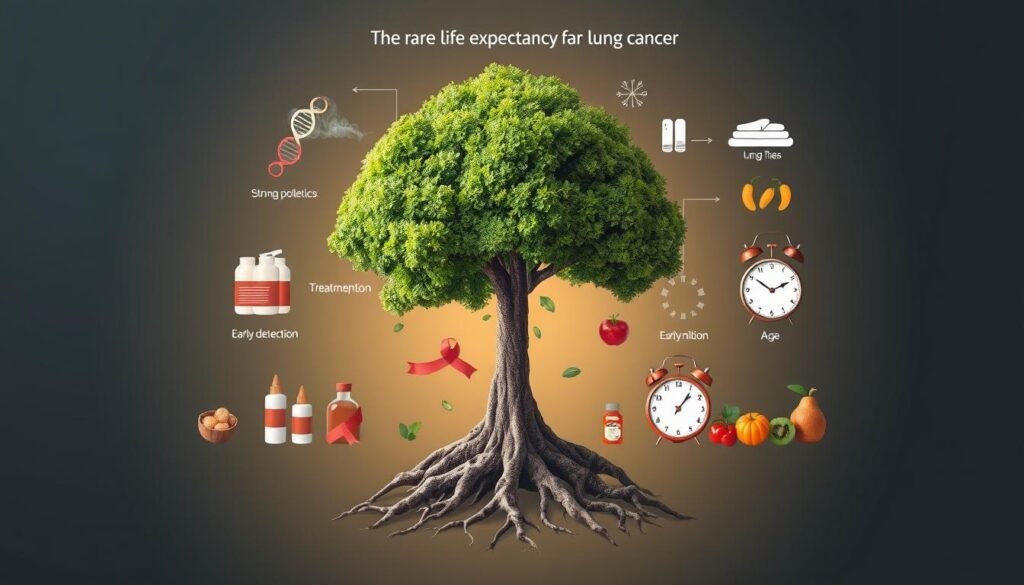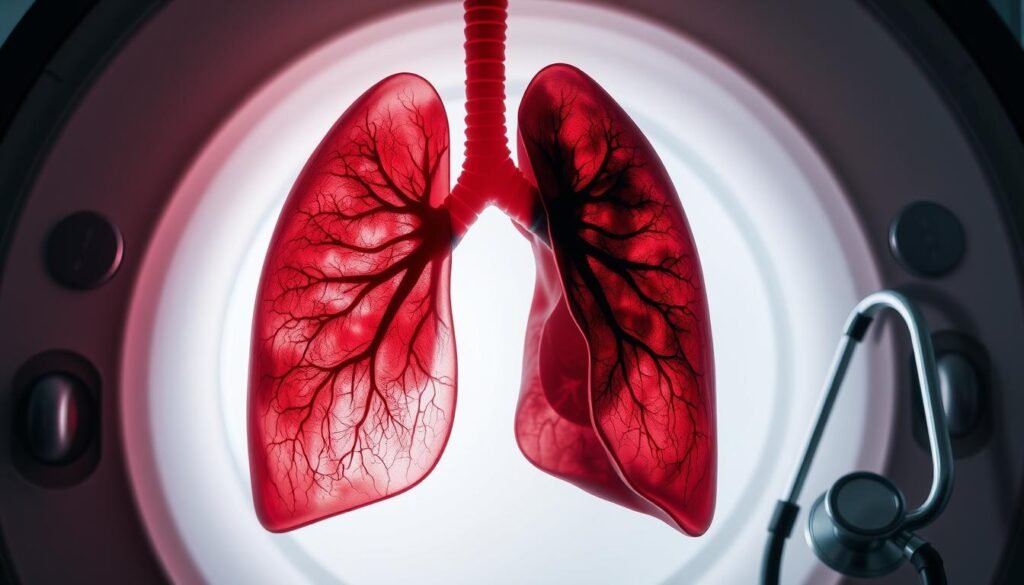Did you know that lung cancer has a daunting five-year survival rate of only 5% when found at a distant stage? This fact highlights how serious lung cancer is. It shows why it’s a major health concern in the United States. Lung cancer is the top cause of cancer death. Knowing what is life expectancy with lung cancer is vital for patients, their families, and doctors.
This article gives the newest info on lung cancer survival rates. It talks about prognosis and what affects these outcomes, like the cancer’s stage and treatment options. We use trusted sources such as the American Cancer Society and the National Cancer Institute for our info. You’ll get a clearer idea of lung cancer life expectancy stats and research efforts to boost survival rates.
Key Takeaways
- Lung cancer is the leading cause of cancer mortality in the U.S.
- The overall five-year survival rate for lung cancer is approximately 28% across SEER stages.
- Localized lung cancer has the highest survival rate of 65% for non-small cell lung cancer.
- Early detection significantly improves lung cancer prognosis and survival odds.
- Current research includes over 1,500 ongoing clinical trials to discover innovative treatments.
Understanding Lung Cancer and Its Prevalence
Lung cancer is a major health problem in the US, causing about 25% of all cancer deaths. More people die from lung cancer each year than from breast, prostate, and colorectal cancers combined. It mainly comes in two types: non-small cell lung cancer (NSCLC) and small cell lung cancer (SCLC). NSCLC accounts for 80% to 85% of all cases.
This year, we expect around 234,580 new cases of lung cancer. These cases are almost equally divided between men and women, with men having 116,310 cases and women having 118,270. Lung cancer ranks as the second most common cancer for both genders. It comes after prostate cancer in men and breast cancer in women.
About 125,070 people may die from lung cancer this year. This shows how deadly the disease continues to be. An American is diagnosed with lung cancer every two minutes, stressing the need for more awareness. Sadly, over 361 individuals in the US die from lung cancer each day.
To understand lung cancer, we should know its risk factors. These include smoking, secondhand smoke exposure, air pollution, and workplace hazards. Age is also important, as the average age at diagnosis is 70. Most patients are over 65. Furthermore, the risk of getting lung cancer varies by race. Black men have a 12% higher chance of getting lung cancer than White men. However, Black women have a lower risk compared to White women.
Screening has seen big improvements lately. It’s crucial for high-risk people, but only 16.0% who should be screened get it. Increasing screening among these people is key to reducing lung cancer’s devastating effects.
What Is Life Expectancy with Lung Cancer
Lung cancer life expectancy depends on several factors. These include the type of cancer, its stage at diagnosis, and the person’s overall health. The prognosis and treatment plans are shaped by these factors. Relative survival rates are important for understanding prognosis. They compare lung cancer patients’ survival to that of the general population.
Overview of Survival Rates
Survival chances for lung cancer patients are measured with the five-year relative survival rate. This rate shows the likelihood of patients living at least five years after diagnosis. For early-stage non-small cell lung cancer, survival rates look hopeful. Reports suggest 70% to 92% of these patients survive beyond five years.
| Stage | Five-Year Survival Rate |
|---|---|
| Stage 1a1 | 92% |
| Stage 1a2 | 83% |
| Stage 1a3 | 77% |
| Stage 1b | 68% |
It’s vital to understand these survival rates. For localized NSCLC, the five-year survival rate is about 65%. Age and performance status greatly impact this rate.
How Life Expectancy Is Measured
Life expectancy is figured out by looking at clinical data, health records, and statistical models. The CDC and NCI provide vital statistics. The ECOG performance status is an important index. It classifies patients by how well they can do everyday activities. This classification significantly affects survival rates.
For instance, those classified as PS 0 have a 45.9% survival rate. But, people with a PS 4 status have a drastically lower chance at 0%. This shows how critical it is to monitor a patient’s health situation. It helps us understand life expectancy with lung cancer better.
Lung Cancer Survival Rates Across Different Stages
Knowing how lung cancer survival rates change with each stage is key. It helps figure out prognosis and treatment options. Survival rates differ a lot by stage. This shows how crucial early detection is for localized lung cancer. It also shows the struggles in the later stages.
Localized Stage Survival Rates
Localized lung cancer hasn’t spread beyond the lungs. Here, the outlook is more positive. The 5-year relative survival rate is about 65% for non-small cell lung cancer (NSCLC). It’s around 30% for small cell lung cancer (SCLC). This highlights the big role of finding lung cancer early.
Regional Stage Survival Rates
Once lung cancer moves to the regional stage, it spreads to nearby areas or lymph nodes. Here, survival rates fall sharply. The 5-year rate for NSCLC at this stage is 37%. For SCLC, it goes down to 18%. A big drop like this shows why it’s important to catch and treat lung cancer early.
Distant Stage Survival Rates
At the distant stage, cancer has spread to other organs. Survival rates drop a lot. The overall 5-year rate for NSCLC is 9%. For SCLC, it’s about 3%. These numbers stress the need for better treatments. We need to improve how we handle late-stage lung cancer.
| Stage | NSCLC Survival Rate | SCLC Survival Rate |
|---|---|---|
| Localized | 65% | 30% |
| Regional | 37% | 18% |
| Distant | 9% | 3% |
Lung Cancer Prognosis and Its Implications
The survival outlook for people with lung cancer changes a lot. It depends on the cancer’s stage, the person’s overall health, age, and how well they respond to treatment. Knowing these factors is key because they deeply affect how a patient deals with the disease.
Factors Affecting Survival Odds
There are important factors that shape the lung cancer prognosis for patients. They include:
- Cancer Stage: People with early-stage lung cancer usually live longer than those with cancer that has spread.
- Age: Generally, younger patients have better survival prospects than older ones.
- Health Status: Those who are otherwise healthy tend to do better with treatments.
- Treatment Response: How well a treatment works is crucial for extending life.
For deeper insights on how these factors affect life expectancy, check out this resource.
The Importance of Early Detection
Catching lung cancer early is crucial. Sadly, many people get diagnosed late because there are few signs early on. This often leads to worse survival rates. Right now, only 26.6% of lung cancer cases are caught early.
In 2022, Massachusetts was a leader in screening, with a detection rate of 11.9%. This shows how early action can make a big difference. Increasing public awareness and access to screening like low-dose CT scans can save lives for those at risk.
Lung Cancer Life Expectancy Statistics: Comparison between NSCLC and SCLC
It is important to know the life expectancy differences between NSCLC and SCLC. Each type poses different challenges and treatment options. Looking at the five-year survival rates shows a big gap between these lung cancers.
Five-Year Survival Rates for Non-Small Cell Lung Cancer
People with NSCLC tend to live longer than those with SCLC. The five-year survival rate for NSCLC is around 23%. When we look at the stages of cancer, the numbers change like this:
| Stage | Five-Year Survival Rate |
|---|---|
| Localized | 60% |
| Regional | 33% |
| Distant | 6% |
Five-Year Survival Rates for Small Cell Lung Cancer
The outlook for SCLC is not as good. This type of cancer is more aggressive, and survival rates are lower:
| Condition | Five-Year Survival Rate |
|---|---|
| Localized | 29% |
| Distant | 3% |
These statistics underscore the need for specific care approaches. SCLC spreads quickly and is quite aggressive, contrasting with NSCLC’s better outlook. Knowing this helps people make better treatment choices.
The Role of Treatment in Lung Cancer Prognosis
Lung cancer treatments are vital in improving a patient’s prognosis. Options include surgery, chemotherapy, radiation, targeted therapy, and immunotherapy. The choice depends on the cancer’s type and stage. New therapies have greatly improved many patients’ chances of survival.
Types of Treatments Available
Each treatment for lung cancer has unique benefits:
- Surgery: Often used for early-stage non-small cell lung cancer (NSCLC), including lobectomy and pneumonectomy.
- Chemotherapy: Given in cycles to destroy cancer cells, used before and after surgery.
- Radiation Therapy: Helps control localized tumors, often used with other treatments.
- Targeted Therapy: Attacks cancer cells’ specific features, beneficial in genetically driven cases.
- Immunotherapy: Boosts the body’s immune response to cancer, used for advanced cases.
Impact of New Therapies on Survival Rates
Recent advances in lung cancer treatment have significantly bettered patient outcomes. Targeted therapies and immunotherapies have changed the treatment game, offering better response rates and less toxicity. Researching new treatments is critical as clinical trials test their effectiveness in different groups.
Thanks to these innovations, survival rates have risen dramatically. The five-year survival rate for lung cancer is now around 25%. Moreover, integrating vitamin and mineral supplements has shown to reduce death rates, highlighting the power of combining holistic and traditional treatments.

| Treatment Type | Effectiveness | Targeted Conditions |
|---|---|---|
| Surgery | High for early-stage cancer | NSCLC |
| Chemotherapy | Varied response rates | NSCLC and SCLC |
| Radiation Therapy | Effective for localized cancers | NSCLC |
| Targeted Therapy | High in specific cases | Genetically driven NSCLC |
| Immunotherapy | Promising for recurrent cases | NSCLC and SCLC |
Lung Cancer Stages: What They Mean for Survival
For anyone touched by lung cancer, knowing the stages is crucial. The TNM system helps us understand it by looking at three things: the size and place of the tumor (T), if lymph nodes are involved (N), and if it has spread (M). This info helps choose treatments and gives clues about survival chances.
Understanding the TNM Staging System
The TNM system is key for figuring out how far the cancer has spread. Doctors use tests and biopsies to give it a “clinical stage.” Then, if there’s surgery, they add what they found to give a “pathological stage.” If the cancer comes back, they check it again to see if it has changed.
Not all lung cancers are the same. For the kind called non-small cell lung cancer, stages go from 0 (least spread) to IV (most spread). But small cell lung cancer is split just into “limited” and “extensive,” pointing out how important it is to get the right diagnosis and treatment plan.
Survival Rates by Specific Lung Cancer Stages
The stage of lung cancer when found can greatly affect survival rates. If caught early, the five-year survival rate is about 61%. But if it’s widespread, that number drops to 7%. This shows how key early detection and treatment are for better results.
By using the TNM system well, patients get care that matches their lung cancer stage. Knowing about survival rates and what each stage means drives home the need for spotting and treating cancer early. This can make a big difference in fighting the disease.
Factors Affecting Lung Cancer Life Expectancy
Many elements are crucial in figuring out lung cancer life expectancy. Knowing these factors helps to better understand treatments and survival chances.
Age and Overall Health as Influencers
Age and health play big roles in lung cancer survival. Usually, younger people have better results than older ones because they tend to have fewer health issues. Being older often means having more health problems, which can make fighting lung cancer harder.
Staying in good health can make treatments work better. It also helps improve the quality of life.
Genetic Factors and Cancer Subtypes
Genetics can hugely affect lung cancer outcomes. These include specific mutations found in tests that can change how the disease progresses and responds to treatment. Types of lung cancer, like adenocarcinoma and squamous cell carcinoma, also affect survival differently.
Knowing these genetic details can lead to more personalized treatment plans. This increases the chance of better results.

To get a deeper look at lung cancer and its impact, read this detailed article.
Research Developments and Future Outlook
Recent work in lung cancer research brings hope of better outcomes for patients. New discoveries lead to advancements in treating this disease. Current research focuses on clinical trials to find more effective and personalized treatments.
Current Clinical Trials in Lung Cancer Treatment
Over 1,500 active clinical trials are exploring lung cancer treatments in the U.S. These studies look into new treatments like targeted therapies and immunotherapy. One example is osimertinib, which has been effective for some lung cancer patients.
Researchers are tackling the issue of resistance to therapy. They aim to discover treatments that overcome this challenge.
Improving Survival Rates Over the Years
Data shows lung cancer survival rates have improved. However, only 20% of patients live more than five years after diagnosis. This varies by the type and stage of cancer.
Personalized medicine may increase these numbers. Collaborations in research can lead to better understanding and treatments. This brings hope for the future of those with lung cancer.
Lung Cancer Early Detection: The Key to Survival
Finding lung cancer early is key to beating it. Lung cancer is a top cause of cancer deaths, so it’s critical to get screened. Programs like low-dose CT scans help those at risk, like heavy smokers, find the disease early. This can make a big difference in treatment and survival.
Importance of Screening Programs
Screening programs are vital in catching lung cancer early. The U.S. Preventive Services Task Force advises yearly low-dose CT scans for those 50 to 80 years old with a heavy smoking history. Still, less than 6 percent of those who should get screened actually do. Early screening spots cancer sooner, greatly improving survival chances. For example, people found to have lung cancer early by CT scan have a survival rate of about 81 percent after 20 years.
Advancements in Detection Technologies
There’s been big progress in technology to find lung cancer early. New biomarker tests and better imaging have made it easier to spot lung cancer sooner. Research has shown those with Stage 1A lung cancer, with tumors 10 mm or smaller, have a 92 percent chance of surviving 20 years. Using these new technologies is key to diagnosing lung cancer early, which helps save lives.

| Screening Method | Detected Cases (%) | Malignant Cases (%) |
|---|---|---|
| Low-Dose CT | 23 | 2.7 |
| Chest Radiography | 7 | 0.7 |
To fight lung cancer’s severe impact, it’s critical to use effective screening programs and the latest detection technologies.
Conclusion
The lung cancer life expectancy conclusion is complex. It depends on several things like the disease stage, treatments, and the person’s general health. The five-year survival rate for lung cancer patients is between 9.5% to 16.8%. This shows how tough and serious lung cancer can be.
A lot of lung cancer patients find out they have it at a late stage. This is especially true in places like the USA and the UK. Here, about 79% and 67.6% of patients, respectively, are diagnosed at stage III or IV.
It’s very important to understand the summary of lung cancer prognosis. This is because research is always finding new ways to treat it and detect it early. Older patients often have a harder time surviving the disease. This shows the need for care plans that consider a person’s age and how advanced their cancer is.
New treatments are making progress. But, surviving advanced lung cancer still remains a big challenge.
For people with lung cancer and their families, getting thorough information and support is key. Knowing more helps you make better health care choices. This leads to better, more personal care in fighting lung cancer.